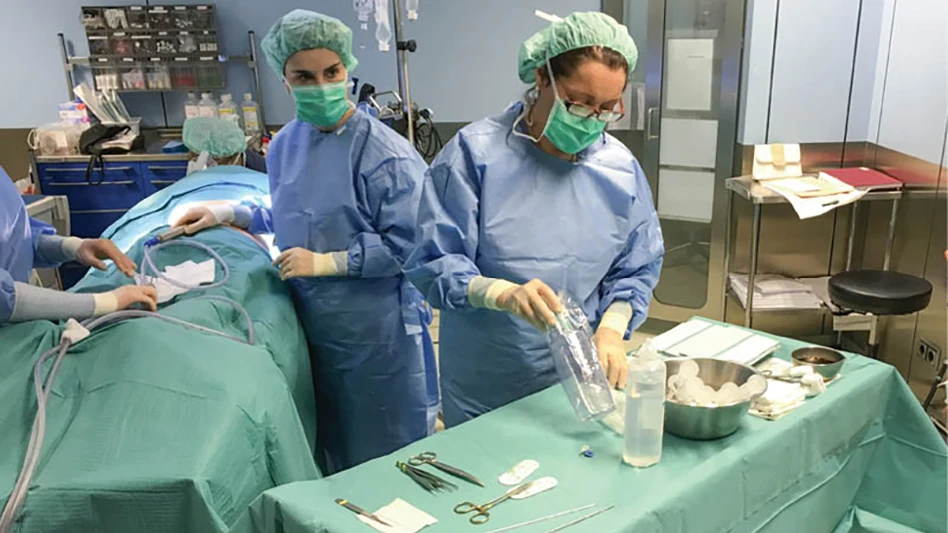
South San Francisco, California – Officials from Profusa Inc., a leading developer of tissue-integrated biosensors, announced that the National Institutes of Health has awarded it a $1.75 million grant under the Small Business Innovation Research (SBIR) program. Administered by the National Heart, Lung, and Blood Institute (NHLBI), the funding will support Fast-tracked Phase I and Phase II studies of the company's Lumee tissue-integrated biosensors for continuous monitoring of oxygen toward improving the clinical outcomes of patients suffering from peripheral artery disease (PAD).
"This NIH award is further validation of the potential of our biosensor technology for having a significant impact in transforming clinical outcomes for patients with PAD," said Ben Hwang, Ph.D., Profusa's chairman and chief executive officer. "These studies will be crucial in advancing our technology and products towards regulatory approvals and commercialization."

The Phase I of the grant will fund safety studies of the Lumee technology, and Phase II will fund a clinical study of the technology at the University of California San Francisco. The grant is the second Fast-track small business grant Profusa has received from the NHLBI for development of its tissue-integrated oxygen biosensors for PAD.
 Natalie Wisniewski, Ph.D., a co-principal investigator of the studies and Profusa's co-founder and chief technology officer, said, "Our goal is to further demonstrate the functionality of Profusa's novel Lumee oxygen biosensor technology in patients with PAD, and to determine its ability to predict surgical outcomes and to guide additional therapies to avoid amputation."
Natalie Wisniewski, Ph.D., a co-principal investigator of the studies and Profusa's co-founder and chief technology officer, said, "Our goal is to further demonstrate the functionality of Profusa's novel Lumee oxygen biosensor technology in patients with PAD, and to determine its ability to predict surgical outcomes and to guide additional therapies to avoid amputation."
 Phase I of the program is aimed at verifying the biocompatibility of the biosensors, which to date have been shown to be functional for more than two years within the body. Phase II includes a 50-patient clinical trial to be conducted by co-principal investigator Christopher Owens, M.D., M.Sc., associate professor of surgery, division of vascular and endovascular surgery at the University of California San Francisco. Owens also serves as chief, section of vascular surgery, San Francisco VA Medical Center, and director of the vascular integrated physiology ad experimental therapeutics laboratory at UCSF.
Phase I of the program is aimed at verifying the biocompatibility of the biosensors, which to date have been shown to be functional for more than two years within the body. Phase II includes a 50-patient clinical trial to be conducted by co-principal investigator Christopher Owens, M.D., M.Sc., associate professor of surgery, division of vascular and endovascular surgery at the University of California San Francisco. Owens also serves as chief, section of vascular surgery, San Francisco VA Medical Center, and director of the vascular integrated physiology ad experimental therapeutics laboratory at UCSF.
"Profusa's oxygen-sensing technology may allow doctors for the first time to know the tissue oxygen levels in the ischemic limb before, during, and after treatment," explained Dr. Owens. "We'll be able to more accurately select patients who will need a revascularization procedure to heal their wounds, and we will be able to monitor the change in tissue oxygen during and after the procedure in order to guide our treatment and know when it is complete. The upside for our patients will be less pain and disability, improved function, and fewer amputations."
Peripheral artery disease
PAD affects 202 million people worldwide, 27 million of whom live in Europe and North America, with an annual economic burden of more than $74 billion in the U.S. alone. PAD is caused by plaque buildup in the blood vessels of the legs, resulting in decreased delivery of vital nutrients and oxygen necessary to maintain healthy tissue. As the disease advances, patients can experience significant leg pain with impaired mobility (claudication), and in its most severe form, critical limb ischemia (CLI), gangrene and limb amputation.
Lumee oxygen sensing system
Profusa's first medical product, the Lumee Oxygen Sensing System, is aimed at being the only long-term monitoring technology that prompts therapeutic action to ensure tissue oxygen levels persist throughout the PAD treatment and healing process. Pending CE Mark, the Lumee system is slated to be available in Europe in 2016 for use by vascular surgeons and wound-healing specialists.
Profusa Inc.
Profusa Inc., based in South San Francisco, California, is leading the development of a new generation of tissue-integrated sensors that empowers an individual with the ability to monitor their unique body chemistry in unprecedented ways to transform the management of personal health and disease. Overcoming the body's response to foreign material for long-term use, its technology promises to be the foundational platform of real-time biochemical detection through the development of tiny bioengineered sensors that become one with the body to detect and continuously transmit actionable, medical-grade data for personal and medical use.
Research reported in this press release is supported by the National Heart, Lung, and Blood Institute of the National Institutes of Health under Award Number R44HL131366. The content is solely the responsibility of the authors and does not necessarily represent the official views of the National Institutes of Health.
Source: Profusa Inc.
Latest from Today's Medical Developments
- Best of 2024: #6 Article – Closing the global product information gap
- Best of 2024: #6 News – NUBURU enters medical device market with order Blueacre Technology
- Season's greetings
- Best of 2024: #7 Article – Synchronized machining processes for medtech
- Best of 2024: #7 News – 3D printing could revolutionize treatment for cataracts, other eye conditions
- Best of 2024: #8 Article – Perfecting the CMP process for surgical blades
- Best of 2024: #8 News – Johnson & Johnson to acquire Shockwave Medical
- Best of 2024: #9 Article – Strategy Milling combines old and new for precision dental restorations





